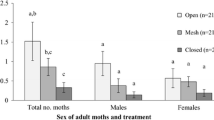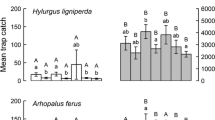Abstract
Female emerald ash borers, Agrilus planipennis (Coleoptera: Buprestidae), emit a macrocyclic lactone, (Z)-3-dodecen-12-olide, that increases field trap captures on large-panel prism traps when co-emitted with the green leaf volatile (Z)-3-hexenol. We assessed attraction to these compounds by using visual decoy-baited branch traps, which attract males by mimicking a living female resting upon a leaf. Pairs of branch traps, with and without visual decoy beetles, were placed on green ash, Fraxinus pennsylvanica, trees, which were assigned different odor treatments: 1) no odor, 2) (Z)-3-hexenol alone, and 3) (Z)-3-hexenol-plus-lactone. Male captures were positively affected by the presence of decoys and the emission of either (Z)-3-hexenol or (Z)-3-hexenol plus lactone. The decoy-baited traps with the combination of (Z)-3-hexenol plus lactone caught more males than any other treatment. Greater male captures were associated with continuing captures later in the season, suggesting that decoy and odor attractants remain attractive throughout the flight period. Female captures were not affected by the visual decoys, but odors did influence captures, with the (Z)-3-hexenol plus lactone treatment catching the greatest number of females. The rare female trap captures were negatively correlated with the more common male captures on the odorless and (Z)-3-hexenol-baited traps, but were not correlated with male captures when the lactone was added. Thus, in the absence of the lactone, the visual signal of other conspecifics can inhibit female attraction. However, the pheromone attracts both sexes independently of the visual signal on the trap.



Similar content being viewed by others
References
Bartelt R, Cossé AA, Zilkowski BW, Fraser I (2007) Antennally active macrolide from the emerald ash borer Agrilus planipennis emitted predominantly by females. J Chem Ecol 33:1299–1302
Cappaert D, McCullough DG, Poland TM, Siegert NW (2005) Emerald ash borer in North America: a research and regulatory challenge. Am Entomol 51:152–165
Crook DJ, Khrimian A, Francese JA, Fraser I, Poland TM, Sawyer AJ, Mastro VC (2009) Development of a host-based semiochemical lure for trapping emerald ash borer Agrilus planipennis (Coleoptera: Buprestidae). Environ Entomol 37:356–365
DeGroot P, Grant GG, Poland TM, Scharbach R, Buchan L, Nott RW, Macdonald L, Pitt D (2008) Electrophysiological response and attraction of emerald ash borer to green leaf volatiles (GLVs) emitted by host foliage. J Chem Ecol 34:1170–1179
Domingue MJ, Lakhtakia A, Pulsifer DP, Hall LP, Badding JV, Bischof JL, Martín-Palmad RJ, Imrei Z, Janik G, Mastro VC, Hazen M, Baker TC (2014) Bioreplicated visual features of nanofabricated buprestid beetle decoys evoke stereotypical male mating flights. Proc Natl Acad Sci U S A 111:14106–14111
Domingue MJ, Pulsifer DP, Lakhtakia A, Berkebile J, Steiner KC, Lelito JP, Hall LP, Baker TC (2015) Detecting emerald ash borers (Agrilus planipennis) using branch traps baited with 3D-printed beetle decoys. J Pest Sci 88:267–279
Domingue MJ, Lelito JP, Fraser I, Mastro VC, Tumlinson JH, Baker TC (2013a) Visual and chemical cues affecting the detection rate of the emerald ash borer in sticky traps. J Appl Entomol 137:77–87
Domingue MJ, Imrei Z, Lelito JP, Muskovits J, Janik G, Csóka G, Mastro VC, Baker TC (2013b) Field trapping of European oak buprestid beetles using visual and olfactory cues. Entomol Exp Appl 148:116–129
Francese JA, Mastro VC, Oliver JB, Lance DR, Youssef N, Lavallee SG (2005) Evaluation of colors for trapping Agrilus planipennis (Coleoptera: Buprestidae). J Entomol Sci 40:93–95
Francese JA, Crook DJ, Fraser I, Lance DR, Sawyer AJ, Mastro VC (2010) Optimization of trap color for emerald ash borer (Coleoptera: Buprestidae). J Econ Entomol 103:1235–1241
Grant GG, Ryall KL, Lyons DB, Abou-Zaid MM (2010) Differential response of male and female emerald ash borers (Col., Buprestidae) to (Z)-3-hexenol and manuka oil. J Appl Entomol 134:26–33
Grant GG, Poland TM, Ciaramitaro T, Lyons DB, Jones GC (2011) Comparison of male and female emerald ash borer (Coleoptera: Buprestidae) responses to phoebe oil and (Z)-3-hexenol lures in light green prism traps. J Econ Entomol 104:173–179
Haack RA, Jendek E, Liu H, Marchant KR, Petrice TR, Poland TM, Ye H (2002) The emerald ash borer: a new exotic pest in North America. Newsl Mich Entomol Soc 47:1–5
Lelito JP, Fraser I, Mastro VC, Tumlinson JH, Böröczky K, Baker TC (2007) Visually mediated ‘paratrooper copulations’ in the mating behavior of Agrilus planipennis (Coleoptera: Buprestidae), a highly destructive invasive pest of north American ash trees. J Insect Behav 20:537–552
Lelito JP, Fraser I, Mastro VC, Tumlinson JH, Baker TC (2008) Novel visual-cue-based sticky traps for monitoring of emerald ash borers, Agrilus planipennis (Coleoptera: Buprestidae). J Appl Entomol 132:668–674
Lelito JP, Böröczky K, Jones TH, Fraser I, Mastro VC, Tumlinson JH, Baker TC (2009) Behavioral evidence for a contact sex pheromone component of the emerald ash borer, Agrilus planipennis Fairmaire. J Chem Ecol 35:104–110
MacQuarrie CJK, Scarr TA, Ryall KL (2015) The science of the emerald ash borer (Coleoptera: Buprestidae): where are we after 10 years of research? Can Entomol 147:249–251
Rodriguez-Saona C, Poland TM, Miller JR, Stelinski LL, Grant GG, DeGroot P, Buchan L, MacDonald L (2006) Behavioral and electrophysiological responses of the emerald ash borer, Agrilus planipennis, to induced plant volatiles of Manchurian ash, Fraxinus mandshurica. Chemoecology 16:75–86
Ryall K, Silk P, Mayo P, Crook D, Khrimian A, Cossé A, Sweeney J, Scarr T (2012) Attraction of Agrilus planipennis (Coleoptera: Buprestidae) to a volatile pheromone: effects of release rate, host volatile, and trap placement. Environ Entomol 41:648–656
Ryall K, Silk PJ, Fidgen J, Mayo P, Lavallée R, Guertin C, Scarr T (2015) Effects of pheromone release rate and trap placement on trapping of Agrilus planipennis (Coleoptera: Buprestidae) in Canada. Environ Entomol 40:734–745
Silk P, Ryall K (2015) Semiochemistry and chemical ecology of the emerald ash borer Agrilus planipennis (Coleoptera: Buprestidae). Can Entomol 147:277–289
Silk PJ, Ryall K, Lyons DB, Sweeney J, Wu JP (2009) A contact sex pheromone component of the emerald ash borer Agrilus planipennis Fairmaire (Coleoptera: Buprestidae). Naturwissenschaften 96:601–608
Silk PJ, Ryall K, Mayo P, Lemay MA, Grant G, Crook D, Cossé A, Fraser I, Sweeney JD, Lyons DB, Pitt D, Scarr T, Magee D (2011) Evidence for a volatile pheromone in Agrilus planipennis Fairmaire (Coleoptera: Buprestidae) that increases attraction to a host foliar volatile. Environ Entomol 40:904–916
Silk PJ, Ryall K, Mayo P, MaGee DI, Leclair G, Fidgen J, Lavallee R, Price J, McConaghy J (2015) A biologically active analog of the sex pheromone of the emerald ash borer, Agrilus planipennis. J Chem Ecol 41:294–302
Steiner KC, Williams MW, DeHayes DH, Hall RB, Eckert RT, Bagley WT, Lemmien WA, Karnosky DF, Carter KK, Cech FC (1988) Juvenile performance in a range-wide provenance test of Fraxinus pennsylvanica marsh. Silvae Genet 37:104–111
Acknowledgments
We thank Dr. Kim Steiner and Jennifer Berkebile of the Penn State Department of Forestry for assistance in providing information about the experimental plot. Loyal Hall and Kevin Cloonan of the Penn State Department of Entomology and Haibin Chen of Wenzhou Medical University, China assisted in trap collection. Lucas Roscoe of Natural Resources Canada provided useful suggestions for the initial manuscript of this work. The work was funded by the United States Department of Agriculture, Animal and Plant Health Inspection Service program supporting the Development of Detection Tools for Exotic Buprestid Beetles (12-8130-1430-CA). We thank CFS and ACOA-AIF, Canada for partial funding to PS and KR.
Author information
Authors and Affiliations
Corresponding author
Electronic Supplementary Material
Supplementary Figure 1
Decoy-baited branch trap, one of which has several Agrilus planipennis adults ensnared (a), and another showing a (Z)-3-hexenol packet attached below the trap surface (b). (GIF 60 kb)
Supplementary Figure 2
Graphical depiction of the experimental plot on the Pennsylvania State University campus in University Park, PA, (40°48′31.5″N 77°50′25.1″W, 318 m altitude). The locations of living Fraxinus trees are marked with a zero. Empty spaces indicate positions where trees were not planted or have died since the beginning if the Agrilus planipennis infestation. Red boxes are overlaid above trees where traps were deployed. Within each group of two or three trees circled, different odor treatments were always deployed. Traps were rotated twice within the groups of three and between the groups of two as further described in the text. (GIF 792 bytes)
Rights and permissions
About this article
Cite this article
Domingue, M.J., Andreadis, S.S., Silk, P.J. et al. Interaction of Visual and Chemical CUES in Promoting Attraction of Agrilus planipennis . J Chem Ecol 42, 490–496 (2016). https://doi.org/10.1007/s10886-016-0706-y
Received:
Revised:
Accepted:
Published:
Issue Date:
DOI: https://doi.org/10.1007/s10886-016-0706-y




